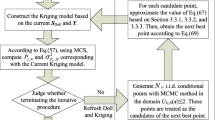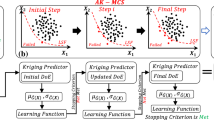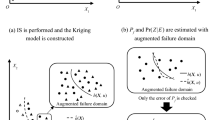Abstract
For structural reliability analysis with time-consuming performance functions, an innovative design of experiment (DoE) strategy of the Kriging model is proposed, which is named as the stepwise accuracy-improvement strategy. The epistemic randomness of the performance value at any point provided by the Kriging model is used to derive an accuracy measure of the Kriging model. The basic idea of the proposed strategy is to enhance the accuracy of the Kriging model with the best next point that has the largest improvement with regard to the accuracy measure. An optimization problem is developed to define the best next point. The objective function is the expectation that quantifies how much an untried point could enhance the accuracy of the Kriging model. Markov chain Monte Carlo sampling and Gauss–Hermite quadrature are employed to make several approximations to solve the optimization problem and get the best next point. A structural reliability analysis method is also constructed based on the proposed strategy and the accuracy measure employed. Several examples are studied. The results validate the advantages of the proposed DoE strategy.
















Similar content being viewed by others
References
Alibrandi U, Alani AM, Ricciardi G (2015) A new sampling strategy for SVM-based response surface for structural reliability analysis. Probab Eng Mech 41:1–12
Au S-K (2016) On MCMC algorithm for subset simulation. Probab Eng Mech 43:117–120
Au SK, Beck JL (2001) Estimation of small failure probabilities in high dimensions by subset simulation. Probab Eng Mech 16(4):263–277
Balesdent M, Morio J, Marzat J (2013) Kriging-based adaptive importance sampling algorithms for rare event estimation. Struct Saf 44:1–10
Bect J et al (2012) Sequential design of computer experiments for the estimation of a probability of failure. Stat Comput 22(3):773–793
Beers WCMV, Kleijnen JPC (2003) Kriging for interpolation in random simulation. J Oper Res Soc 54(3):255–262
Bichon BJ et al (2008) Efficient global reliability analysis for nonlinear implicit performance functions. AIAA J 46(10):2459–2468
Blatman G, Sudret B (2010) An adaptive algorithm to build up sparse polynomial chaos expansions for stochastic finite element analysis. Probab Eng Mech 25(2):183–197
Blatman G, Sudret B (2011) Adaptive sparse polynomial chaos expansion based on least angle regression. J Comput Phys 230(6):2345–2367
Bourinet JM, Deheeger F, Lemaire M (2011) Assessing small failure probabilities by combined subset simulation and support vector machines. Struct Saf 33(6):343–353
Cadini F, Santos F, Zio E (2014) An improved adaptive kriging-based importance technique for sampling multiple failure regions of low probability. Reliab Eng Syst Saf 131:109–117
Cornuet JM et al (2012) Adaptive multiple importance sampling. Scand J Stat 39(4):798–812
Dellino G et al (2009) Kriging metamodel management in the design optimization of a CNG injection system. Math Comput Simul 79(8):2345–2360
Der Kiureghian A (1991) Efficient algorithm for second-order reliability analysis. J Eng Mech 117(12):2904–2923
Dubourg V, Sudret B, Bourinet J-M (2011) Reliability-based design optimization using kriging surrogates and subset simulation. Struct Multidiscip Optim 44(5):673–690
Dubourg V, Sudret B, Deheeger F (2013) Metamodel-based importance sampling for structural reliability analysis. Probab Eng Mech 33:47–57
Echard B, Gayton N, Lemaire M (2011) AK-MCS: an active learning reliability method combining Kriging and Monte Carlo simulation. Struct Saf 33(2):145–154
Echard B et al (2013) A combined importance sampling and kriging reliability method for small failure probabilities with time-demanding numerical models. Reliab Eng Syst Saf 111:232–240
Fauriat W, Gayton N (2014) AK-SYS: an adaptation of the AK-MCS method for system reliability. Reliab Eng Syst Saf 123:137–144
Gaspar B, Teixeira AP, Soares CG (2014) Assessment of the efficiency of kriging surrogate models for structural reliability analysis. Probab Eng Mech 37:24–34
Gaspar B, Teixeira AP, Guedes Soares C (2017) Adaptive surrogate model with active refinement combining Kriging and a trust region method. Reliab Eng Syst Saf 165:277–291
Gayton N, Bourinet JM, Lemaire M (2003) CQ2RS: a new statistical approach to the response surface method for reliability analysis. Struct Saf 25(1):99–121
Hu Z, Mahadevan S (2016a) A single-loop Kriging surrogate modeling for time-dependent reliability analysis. J Mech Des 138(6):061406
Hu Z, Mahadevan S (2016b) Global sensitivity analysis-enhanced surrogate (GSAS) modeling for reliability analysis. Struct Multidiscip Optim 53(3):501–521
Huang X, Chen J, Zhu H (2016) Assessing small failure probabilities by AK-SS: an active learning method combining kriging and subset simulation. Struct Saf 59:86–95
Jian W et al (2017) Two accuracy measures of the kriging model for structural reliability analysis. Reliab Eng Syst Saf 167:494–505
Jones DR, Schonlau M, Welch WJ (1998) Efficient global optimization of expensive black-box functions. J Glob Optim 13(4):455–492
Kaymaz I (2005) Application of kriging method to structural reliability problems. Struct Saf 27(2):133–151
Kleijnen JPC (2009) Kriging metamodeling in simulation: a review. Eur J Oper Res 192(3):707–716
Li J, Wang H, Kim NH (2012) Doubly weighted moving least squares and its application to structural reliability analysis. Struct Multidiscip Optim 46(1):69–82
Lv Z, Lu Z, Wang P (2015) A new learning function for kriging and its applications to solve reliability problems in engineering. Comput Math Appl 70(5):1182–1197
Marrel A et al (2008) An efficient methodology for modeling complex computer codes with Gaussian processes. Comput Stat Data Anal 52(10):4731–4744
Matheron G (1973) The intrinsic random functions and their applications. Adv Appl Probab 5(3):439–468
Melchers RE (1990) Radial importance sampling for structural reliability. Jof Engrgmechasce 116(1):189–203
Neal RM (2003) Slice sampling. Ann Stat 31(3):705–767
Nguyen XS et al (2009) Adaptive response surface method based on a double weighted regression technique. Probab Eng Mech 24(2):135–143
Owen AB (2000) Monte Carlo, quasi-Monte Carlo, and randomized quasi-Monte Carlo. In: Niederreiter H, Spanier J (eds) Monte Carlo and Quasi-Monte Carlo methods 1998. Springer-Verlag Berlin, Berlin, pp 86–97
Owen A, Zhou Y (2000) Safe and effective importance sampling. J Am Stat Assoc 95(449):135–143
Pedroni N, Zio E, Apostolakis GE (2010) Comparison of bootstrapped artificial neural networks and quadratic response surfaces for the estimation of the functional failure probability of a thermal-hydraulic passive system. Reliab Eng Syst Saf 95(4):386–395
Perrin G (2016) Active learning surrogate models for the conception of systems with multiple failure modes. Reliab Eng Syst Saf 149:130–136
Picheny V et al (2010) Adaptive designs of experiments for accurate approximation of a target region. J Mech Des 132(7):071008
Pradlwarter HJ et al (2007) Application of line sampling simulation method to reliability benchmark problems. Struct Saf 29(3):208–221
Roussouly N, Petitjean F, Salaun M (2013) A new adaptive response surface method for reliability analysis. Probab Eng Mech 32:103–115
Saha N, Naess A (2010) Monte Carlo-based method for predicting extreme value statistics of uncertain structures. J Eng Mech-ASCE 136(12):1491–1501
Salemi P, Nelson BL, Staum J (2016) Moving least squares regression for high-dimensional stochastic simulation metamodeling. ACM Trans Model Comput Simul 26(3):1–25
Schöbi R, Sudret B (2014) Combining polynomial chaos expansions and Kriging for solving structural reliability problems. In: Spanos P, Deodatis G, (eds). Proceedings of the 7th international conference on computational stochastic mechanics (CSM7). Santorini, Greece
Schueremans L, Van Gemert D (2005) Benefit of splines and neural networks in simulation based structural reliability analysis. Struct Saf 27(3):246–261
Shi X et al (2015) Kriging response surface reliability analysis of a ship-stiffened plate with initial imperfections. Struct Infrastruct Eng 11(11):1450–1465
Song H et al (2013) Adaptive virtual support vector machine for reliability analysis of high-dimensional problems. Struct Multidiscip Optim 47(4):479–491
Sun Z et al (2017) LIF: a new kriging based learning function and its application to structural reliability analysis. Reliab Eng Syst Saf 157:152–165
Tong C et al (2015) A hybrid algorithm for reliability analysis combining kriging and subset simulation importance sampling. J Mech Sci Technol 29(8):3183–3193
Wang ZQ, Wang PF (2014) A maximum confidence enhancement based sequential sampling scheme for simulation-based design. J Mech Des 136(2):021006
Wen Z et al (2016) A sequential Kriging reliability analysis method with characteristics of adaptive sampling regions and parallelizability. Reliab Eng Syst Saf 153:170–179
Yang X et al (2015) An active learning kriging model for hybrid reliability analysis with both random and interval variables. Struct Multidiscip Optim 51(5):1003–1016
Zhang H, Mullen RL, Muhanna RL (2010) Interval Monte Carlo methods for structural reliability. Struct Saf 32(3):183–190
Zhang Y et al (2015) An efficient Kriging method for global sensitivity of structural reliability analysis with non-probabilistic convex model. Proc Inst Mech Eng O J Risk Reliab 229(5):442–455
Zhao YG, Ono T (1999) A general procedure for first/second-order reliability method (FORM/SORM). Struct Saf 21(2):95–112
Author information
Authors and Affiliations
Corresponding author
Rights and permissions
About this article
Cite this article
Wang, J., Sun, Z. The stepwise accuracy-improvement strategy based on the Kriging model for structural reliability analysis. Struct Multidisc Optim 58, 595–612 (2018). https://doi.org/10.1007/s00158-018-1911-9
Received:
Revised:
Accepted:
Published:
Issue Date:
DOI: https://doi.org/10.1007/s00158-018-1911-9




